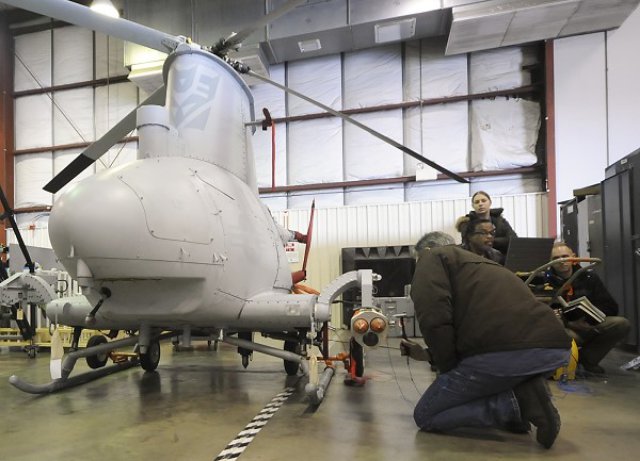A team at Webster Field Annex is working briskly to support an urgent Navy request to weaponize the MQ-8B Fire Scout, marking the first time the Navy will arm an unmanned aircraft.
The Fire Scout team and NAVAIR’s structures rotary-wing division personnel conducted the first of a series of tests March 7 on the newly installed hardware, which will gauge how the system will operate in the shipboard environment.
“This is the very first weaponization program on this aircraft,” said Jeremy Moore, Fire Scout weapons system integration lead. Part of the Rapid Deployment Capability (RDC) acquisition process, “it was identified by the fleet as an urgent need for joint forces, so we are pressing forward as hard as we can to get it out there.”
The Navy plans to arm the MQ-8B Fire Scout with a laser-guided rocket, the Advanced Precision Kill Weapon System (APKWS), in just 18 months. Typically, this type of development would take two to three years at a minimum, Moore said. Arming the Fire Scout with a guided rocket will enable the fleet to engage hostile threats with the Fire Scout independent of air support from carrier or shore-based aircraft. This capability will keep the warfighter out of harm’s way, Moore said.
Bill McCartney, Fire Scout’s Air Vehicle flight test lead, said the weaponization of any aircraft is an intricate process, particularly it in this case since it is the first time the Navy will arm an unmanned aircraft.
“We had a very tight timeline to conduct trade studies and complete design reviews,” McCartney said. “Now, we are starting to execute tests, and there is little time in the schedule for repeats.”
The team planned this test event to get an early look at the new hardware design installed on the aircraft, allowing them to identify any issues before beginning ground and flight tests later this year. Ground and flight tests will be conducted by Naval Air Warfare Center’s Aircraft Division and Weapons Division personnel at Webster Field and China Lake, Calif., with support from NAVAIR, Naval Sea Systems Command and industry partners.
“This is the first stepping stone,” Moore said. “We are trying to build in the capability to add on additional weapons in the future.”
Photo Credit: Kelly Schindler
Source : Naval Air Systems Command

